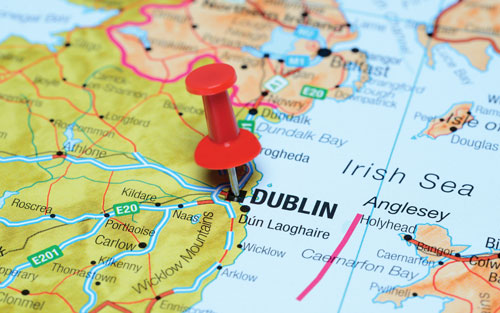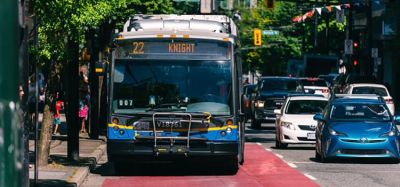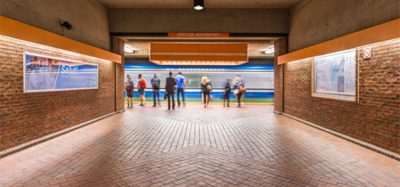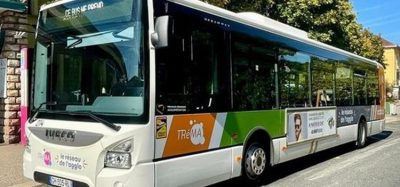Creating and delivering a metro for Dublin’s future
- Like
- Digg
- Del
- Tumblr
- VKontakte
- Buffer
- Love This
- Odnoklassniki
- Meneame
- Blogger
- Amazon
- Yahoo Mail
- Gmail
- AOL
- Newsvine
- HackerNews
- Evernote
- MySpace
- Mail.ru
- Viadeo
- Line
- Comments
- Yummly
- SMS
- Viber
- Telegram
- Subscribe
- Skype
- Facebook Messenger
- Kakao
- LiveJournal
- Yammer
- Edgar
- Fintel
- Mix
- Instapaper
- Copy Link
Posted: 17 December 2015 | Cormac Rabbitt, Managing Director, Metro Dublin | No comments yet
Metro Dublin is a new mass rapid transit network to serve Ireland’s capital city and the country. Cormac Rabbitt, Managing Director of the scheme, explains for Intelligent Transport why and how Metro Dublin propose to create and deliver a cost effective transit metro network for Dublin’s future…


Metro Dublin will extend to 92km with 57 stations when eight shared stops are included. Works will involve the upgrade of 28km of existing lines, 17km of new surface lines and 45km of tunnels. It will run on grade separated tracks from the Irish Rail intercity trains. The network could best be seen as an extended Dublin urban railway network, as shown in Figure 1 on page 59.
For development purposes, Metro Dublin is divided into six contract sections as shown in Figure 2 on page 60, with the existing DART line marked ‘7’. The sections are:
- Glasnevin/Heuston/Docklands – 7.2km
- Malahide/Swords/Glasnevin – 21.2km
- Adamstown/Heuston/Phibsboro – 15.8km
- Blanchardstown/Glasnevin/Docklands – 13.5km
- Ashbourne/Finglas/Glasnevin – 17.2km
- Howth Jn/O’Connell St/Rathfarnham – 17.1km
What’s different about Metro Dublin is its gestation in a private initiative with a relatively low all-in capital cost when compared to previous proposals.
First, a rhetorical question – what could a new low all-in capital cost metro mean for you? If you are a supplier of metro systems I think that it could mean a lot. For example, if two metro lines can be built for the price of one (with better technology and management methods) then the ongoing supplier market will grow significantly for you.
Back in 1998, Metro Dublin, along with others, successfully lobbied the Government to undertake an independent examination between underground metro and over-ground tram options. Government consultants recommended the tram option. The Government rejected their recommendation and favoured a metro, because they believed that a planned Sandyford Line extension southwards to Lahaunstown (which is now a large urban development) and northwards to Dublin Airport needed a full metro…
This explains why Dublin’s Sandyford and Tallaght tram lines did not join – a decision based on sound principles of planning. A similar situation arose in Vienna in the early 1970s when they started to build a super-tram system, parts of which were underground. Halfway through the project they abandoned it in favour of a metro system. The reasons given for this were: a) to preserve Vienna’s dignity; b) to retain the atmosphere of the old city; and c) the realisation that the super-tram would be inadequate to deal with traffic problems.
Two years later, from a presentation that we made with a Japanese consortium to the Irish Cabinet Committee for Infrastructure and Public Private Partnerships, the Government taking account of our estimated costs decided to proceed to upgrade the Sandyford Green Line to a full metro and to continue it northward from Ranelagh under the city centre to Dublin Airport and Swords (Plan).
In 2002, the Irish Railway Procurement Agency (RPA) came up with a modification of the Plan, calling it Metro North, to build a line just from Stephen’s Green (1km north of Ranelagh) to the Airport and Swords. Their plan was for a 14km tram metro line with 6km of it underground and with 14 stations, of which seven were underground, at an estimated all-in cost with funding requirements over 15 years of €4.88 billion with a capital estimate of €3.89 billion in the then current money value.
Looking back on this now I just couldn’t fathom it as Madrid had then recently completed an all underground 11.1km 13 stations underground extension to its Line 7 – see Figure 3 on page 00, at a cost of €424 million. The cost included all design, procurement, construction and management related costs. The line was built in four contract sections, which enabled the works to be completed, from signing of contract to operation, in 28 months. My conclusion was that the RPA’s estimate for their Metro North was questionably significantly larger than the outcome cost of Line 7.
To understand why, I travelled to Madrid and met Professor Manuel Maynar Melis, Director General of Transportation in Madrid. He showed me his new MetroSur Line 12, which has 40.5km underground with 28 stations which he had almost completed. Its all-in final cost excluding financing interest and fees was €1.86 billion and took 35 months to complete.
Again, I made a comparison and my calculations were that the RPA Metro North Capital estimate was questionably more than what Madrid incurred. The reason why the cost of Line 12 was so much lower then Dublin (and other metro systems), I concluded, was the skills that the management team had to manage the system delivery in a short timeframe, and definitely nothing to do with ground conditions as Dublin’s substrata for metro construction is better than Madrid’s.
I think that an important point to note here is that the Madrid Metro is built to one of the highest standards in the world. For example, a good comparative measure of quality is that, in 2010, the combined number of escalators and lifts in the New York, London, Moscow and Tokyo metro systems were respectively 88% and 40% that of Madrid.
My next step was to request the Irish Parliament Joint Committee on Transport to examine the situation. They brought over a Metro de Madrid delegation and then commissioned a Consultant’s Report (O’Reilly) resulting in the estimate cost of Dublin’s Metro North being reduced by some 30% and a recommendation that my (trading as Metro Dublin) ‘undoubted knowledge and many skills that are appropriate for the building of a Metro…could be harnessed for the development of the Dublin Metro system’.
Railway Orders (final planning permissions) were granted for the RPA’s Metro North, in 2010, to build a 16.5km metro (with 10km of it in tunnel) and 14 stations with a capital estimate of €2.5 billion, and to DART Underground for a 7.6km line with six stations with a capital estimated of €3.5 billion – a figure that included additional works on other lines to make it work. The estimated timescale to construct both was six years. In September 2015, both of these schemes were sent back to the drawing boards with the expectation now that only Metro North will open in 2027.
In the foregoing environment (timeline, estimated cost and that only one part of the city would have a new metro line), Metro Dublin recently stepped back into the breach and met with the Irish Planning Board as a prospective applicant for a Railway Order and the Dublin City Council Planning Strategic Planning Committee passed a motion to “…explore the potential for cooperation between Metro Dublin and Dublin City Council to secure the potential benefits of Metro Dublin for the City…”.
In Ireland, development proposals are encouraged and facilitated within the Transport (Railway Infrastructure) Act, 2001. The act provides that ‘any person’ may apply for a railway order. A late Government Minister invited the private sector “to take part in the upgrading of the transport system” and “play a part in developing a more modern transportation system for the city and country.”
It is widely accepted in Ireland and in other countries that there is a strong case for a Government to consider a private initiative in circumstance such as:
- When major infrastructure projects are developed and then shelved (as happened Dublin’s Metro North and DART Underground Developments)
- Under probity of open market requirements as promoted by the Government and the EU and in particular to address the deficit of investment in environmental transport infrastructure
- Where innovative proven ideas with unique elements and intellectual property rights that are in the public interest can be introduced in an open, transparent and value for money competitive manner
- Where it serves a ‘public interest’ and Government policy, objectives and strategy to deliver sustainable infrastructure
- Where developments include unique elements that provide justification for entering into direct discussions with the State Authorities and Agencies
- Can be delivered through a transparent and competitive process.
Metro Dublin’s application for a Railway Order is being developed through the consultative and developmental process set out in Irish Acts and Regulations – a process that is open to scrutiny, debate and criticism. The development works will be transparent through the utilisation of the competitive EU e-tender procurement processes for Multiple Framework Contracts, and dived into nine ‘contract groups’ to facilitate construction completion over 35 months.
Through such processes, Metro Dublin fits in with the Government’s priority to achieve value-for-money outcomes. It will provide fair and equal opportunities for private and public sector participants to partake through open competitive tenders.
On the question of land acquisition, Metro Dublin needs, for most of its development, only to acquire the necessary way-leave land rights to enable its construction, ongoing maintenance and access to stations.
As stated already, the Metro Dublin Development does not conflict with the existing rail services. It runs on grade separated (bridged-over) tracks from the Irish Rail intercity trains and can be seen as complementary to the plans for the Irish Rail DART Underground and the Swiftway bus rapid transit systems. (For instance for people who know Dublin; should DART Underground proceed then platform-to-platform access could be available from the DART Heuston Station directly to the development’s stations at the Dublin Institute of Technology, Dublin City University, Dublin Airport and St James’s Hospital (and the New Children’s Hospital), and from the DART Christchurch Station to O’Connell Street, Croke Park Stadium (capacity 82,300), Beaumont Hospital, Terenure and Rathfarnham).
Metro Dublin with consortium members will fund and bridge-finance the development and after at least two years of metro operation will bring part, or all, of it to market. Metro Dublin has a core team that has capability and credibility to complete its metro development in 2020/2021.
The State, local government and semi-state sector’s main contributions are expected to come in the form of permits, licenses, and assets. The European Union is anticipated to provide finance through the European Investment Bank (EIB) which can be repaid from Local Authority planning development levies (system to do so is already activated), income from railway associated property developments, naming rights, etc. Some of the cash flows from the forgoing are projected to purchase part of the development (asset) over a period of 20 years. The metro is likely to be eligible for funds ear-marked for key railway infrastructure as a cross-border rail project that provides a link to Ireland’s major international airport and to help reduce carbon emissions.
The European guidelines for the State aid to railway undertakings (OJ: C 184 of 22.7.2008) state that where infrastructure use is open to all potential users in a fair and non-discriminatory manner, and access to that infrastructure is charged for at a rate in accordance with community legislation in force, the Commission considers that public financing of the infrastructure does not constitute State aid. If such financing is considered to constitute aid, it may nevertheless be authorised if the infrastructure in question meets the needs of transport coordination.
The state is a significant holder of land on and near the Metro Dublin lines. It owns this land directly/indirectly through Local Authorities, NAMA (Docklands) and state companies like CIÉ/Irish Rail, Dublin Airport Authority, etc. Metro Dublin will open up these lands for more intensive development and considerably add to their values and exchequer cash flow. It will, for instance, help supply the high quality, well-located office locations that the Irish Industrial Authority says are necessary to continue to attract and maintain Foreign Direct Investment and rates for Local Authorities. This along with the underpinning of business rates, increased property transaction taxes such as capital gains and stamp duty taxes mean that the Exchequer will be in positive cash flow during all stages of the development construction and operation.
Biography
Cormac Rabbitt has a Bachelor of Civil and a Master of Industrial Engineering Degrees from the National University of Ireland. He has track record of taking initiatives that helped influence the Irish Government to alter and to proceed with development of motorways and railway, such as building motorways instead of local by-passes to many of Irelands towns and villages, the realignment of significant sections of motorways away from contentious areas that enabled them to be delivered ahead of their listed position and at lower costs. He also played a pioneering role in developing plans that influenced the Irish Government’s decision to develop a metro in Dublin.
Related topics
Business Models, Infrastructure & Urban Planning, Multimodality
Issue
Issue 6 2015
Related modes
Metro
Related cities
Ireland
Related organisations
Metro Dublin








